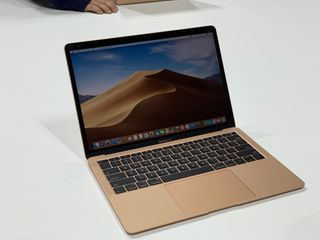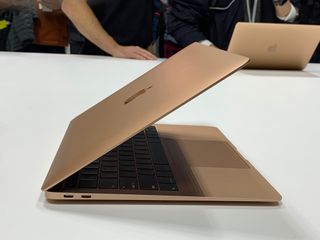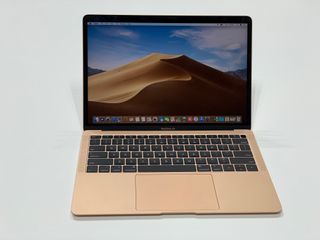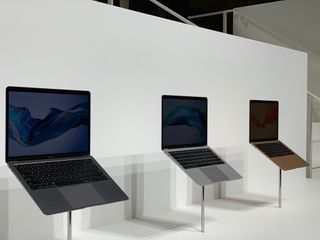New MacBook Air (2018) Hands-On Video

Apple created MacBook Air. MacBook Air killed MacBook. Apple re-created MacBook. MacBook… didn't kill MacBook Air. But it did put it on extended time out. But the spirit of the entry level Apple notebook never dies. And at Apple's "There's More in the Making" event in Brooklyn, New York, we just saw its rebirth.
1. Design
The newly resurrected MacBook Air... looks like the love child of the previous MacBook Air and the 12-inch MacBook. It's smaller and lighter than Air, though not quite so much as the 12-inch.
The screen is 13.3-inches of @2x Retina display. It's not wide gamut DCI-P3, but it is 48% more sRGB than the old Air.
And, yes, of course, Apple has deleted a significant amount of the bezels. The war continues.

But not so much on ports. SD card is gone, much to my chagrin, but the 3.5mm headphone jack remains, and there are two USB-C / TB-3 ports on the left side. I'd have loved them to have been on opposite sides, because I've gotten used to being ambi-chargeable, but I recognize the overhead that adds.
You can use them to plug into anything from an eGPU to a 5K display.
Master your iPhone in minutes
iMore offers spot-on advice and guidance from our team of experts, with decades of Apple device experience to lean on. Learn more with iMore!
The speakers are louder, have more space, and are wider, which is something Apple's been focusing on lately. The force touch trackpad is 20% larger so you can really get your gesture on.
The keys are, yeah, 3rd generation Butterfly, same as the latest MacBook Pro, which you may love, hate, or still be dubious or even terrified about. We'll have to wait and see how they hold up in the real world. But one thing is for certain: Apple's not given up on that base design.
2. Touch ID & T2 Security Chip
There's no Face ID for the Mac yet, though I imagine it'll be there one day. For now, there's Touch ID, much like on the MacBook Pro... but no Touch Bar... which should please some people if not everyone.

That means there's no separate display for Touch ID right beside the fingerprint scanner slash power button, but it otherwise it works just as you'd expect.
There's only one processor option - a 1.6 GHz dual-core Intel Coffee Lake i5. It can turbo boost up to 3.6GHz. It's not as bad as thin as the rebranded CoreM in the 12-inch MacBook, but it's not the full-on I-series in the MacBook Pro either.
That's not great news for people who are used to Air being a full-on I-series system, but for those people, there's a lighter-than-ever MacBook Pro with scads of performance.
There's also a T2 Security Chip, same as the iMac Pro and MacBook Pro, which handles all the secure boot, encryption, and controller architecture... in other words, Apple is offloading everything from Intel that it can, so MacBook Air performs better than what any similar specced machines have any right to.
Especially with the ultra-fast storage which makes swapping to disk almost imperceptible.
You can get up to 1.5 TB of it inside, and up to 16 GB of LPDDR3 RAM as well.
All of that with pretty much the same battery life promises as before - up to 12 hours of web browsing.
3. Pricing & Availability
No multi-touch screens. No Apple Pencil support. If you want those things, you'll have to look at the new iPad Pro. The new MacBook Air comes in space gray, silver, and a new gold that's still kind of roses.

The price starts at $1199.00 which isn't the $999 the previous generation eventually dropped down to, but also isn't as high as the original started at.
More than anything else introduced this week, the new MacBook Air highlights Apple's strategy of going all in on custom and next-generation parts, even if it pushes up the starting price. At least terribly.
For it to work, Apple is going to have to prove significant value over price.
But, like with the new iPad Pro, if the new price is too high, the old one is still around, and still $999.
You can order the new MacBook Air starting today and it ships next week.

Rene Ritchie is one of the most respected Apple analysts in the business, reaching a combined audience of over 40 million readers a month. His YouTube channel, Vector, has over 90 thousand subscribers and 14 million views and his podcasts, including Debug, have been downloaded over 20 million times. He also regularly co-hosts MacBreak Weekly for the TWiT network and co-hosted CES Live! and Talk Mobile. Based in Montreal, Rene is a former director of product marketing, web developer, and graphic designer. He's authored several books and appeared on numerous television and radio segments to discuss Apple and the technology industry. When not working, he likes to cook, grapple, and spend time with his friends and family.
Most Popular





